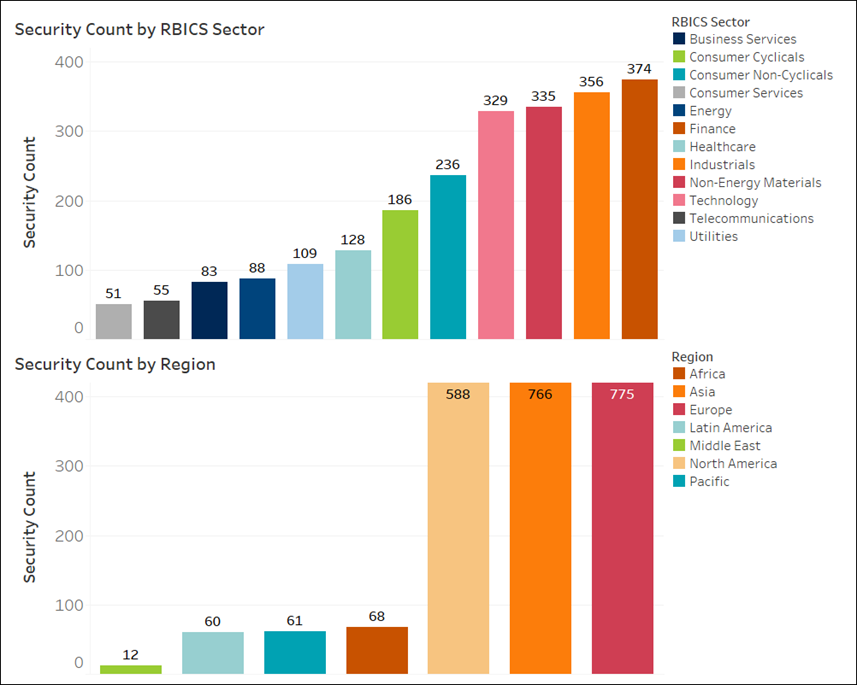Basics
Content Category: ESG
Open:FactSet Page: Click here
Setup a Demo and Access Today: sales@factset.com
Developed by Clarity AI, the Financial Stability Board Task Force on Climate-Related Financial Disclosures (TCFD) score measures organization alignment with TCFD recommendations.
This data feed encompasses approximately 2,500 companies with data as of September 2020. The disclosures are structured around four main thematic areas (i.e., Governance, Strategy, Risk Management, and Metrics & Targets) that represent core elements of how organizations operate. These thematic areas are then divided into several recommended disclosures.
Data Overview
Asset Class: Public Companies
Data Frequency: Monthly
Delivery Frequency: Monthly
History: Data available back to September 2020

Data Methodology
Clarity AI structures TCFDs around the following main thematic areas. Those areas are then divided into 11 recommended disclosures shown below.
- Governance — Discloses the organization's governance around climate-related risks and opportunities.
Recommended Disclosure
|
Description
|
|
Board Oversight
|
Describe the board's oversight of climate-related risks and opportunities.
|
|
Management's Role
|
Describe management's role in assessing and managing climate-related risks and opportunities.
|
- Strategy — Discloses the actual and potential impacts of climate-related risks and opportunities on the organization's businesses, strategy, and financial planning where such information is material.
Recommended Disclosure
|
Description
|
|
Risks and Opportunities
|
Describe the climate-related risks and opportunities the organization has identified over the short, medium, and long term.
|
|
Impact on Organization
|
Describe the impact of climate-related risks and opportunities on the organization's businesses, strategy, and financial planning.
|
|
Resilience of Strategy
|
Describe the resilience of the organization's strategy, taking into consideration different climate-related scenarios, including a 2°C or lower scenario.
|
- Risk Management — Discloses how the organization identifies, assesses, and manages climate-related risks.
Recommended Disclosure
|
Description
|
|
Risk ID and Assessment
Processes
|
Describe the organization's processes for identifying and assessing climate-related risks.
|
|
Risk Management Processes
|
Describe the organization's processes for managing climate-related risks.
|
|
Integration Into Overall Risk Management
|
Describe how processes for identifying, assessing, and managing climate-related risks are integrated into the organization's overall risk management.
|
- Metrics & Targets — Discloses the metrics and targets used to assess and manage relevant climate-related risks and opportunities where such information is material.
Recommended Disclosure
|
Description
|
|
Climate-Related Metrics
|
Disclose the metrics used by the organization to assess climate-related risks and opportunities in line with its strategy and risk management process.
|
|
Scope 1, 2, 3 GHG Emissions
|
Disclose Scope 1, Scope 2, and, if appropriate, Scope 3 greenhouse gas (GHG) emissions and related risks.
|
|
Climate-Related Targets
|
Describe the targets used by the organization to manage climate-related risks and opportunities and performance against targets.
|
The underlying data is collected once a year and delivered to clients following that TCFD questionnaire distribution and collection, which occurs in April. TCFD changes their questions annually to keep feedback relevant.
Use Cases
Clarity AI's scores cater to CIOs/portfolio managers as well as sustainability and compliance officers. This data feed helps investors understand how a company is integrating climate risks and opportunities in its strategy and forward planning, in contrast to just backward reporting. It also supports engagement strategies by identifying areas where companies can improve their practices and disclosures related to climate risks and opportunities.
TCFD alignment scores can be used within the following investment strategies. Price sentiment and fundamental analysis indicators can be leveraged to create a factor used to identify undervalued stocks.
Screening
- Decide which securities should be included or excluded according to the portfolio mandate.
Relative Value
- Determine the relative weighting of securities in a portfolio and tilt it toward more favorable ESG performance on aggregate.
Secular Growth
- Identify assets that fit within sectors offering growth opportunities.
Shareholder Activism
- Identify, target, and track your company's progress toward the investor's ideal outcome.
The details provided above are as of October 2020.
If you have any questions or would like to learn more about any of the content mentioned above, please contact us at sales@factset.com.
Please visit the product page on the Open:FactSet Marketplace for more information: Clarity AI Alignment with TCFD.



